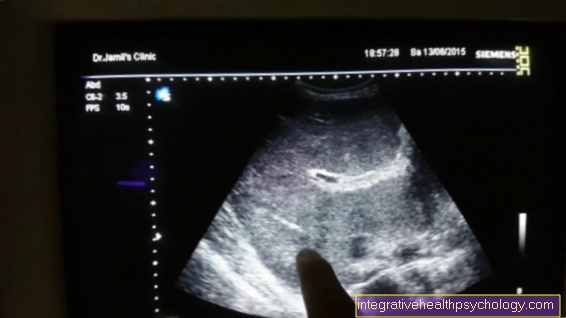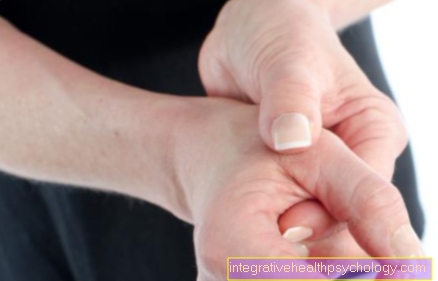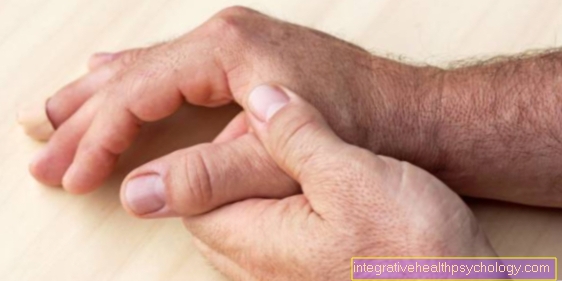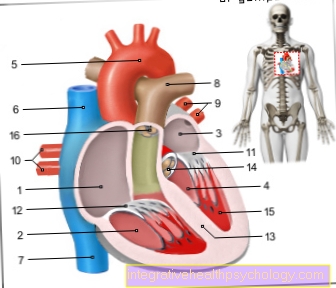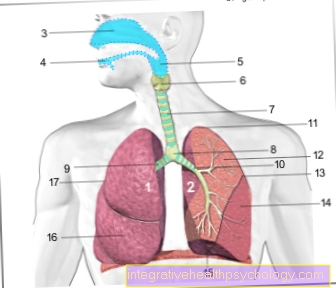Outer wrist pain
definition
The wrists are an anatomically complex structure that is exposed to many everyday stresses, but is also fragile and prone to injury. In addition to the ulna and radius, several carpal bones as well as cartilaginous and connective tissue joint structures are involved in the function of the wrist. Outer wrist pain can be on the side of the radius and thus the thumb side or on the ulna side, the side of the little finger. In particular, the joint parts of the ulna are often affected by everyday stresses and strains in sports, which is why pain on the outer wrist on the side of the little finger is the most common. The pain can develop slowly or come on suddenly after an acute event. Stinging pains are typical when moving that restricts a large number of everyday functions.

causes
The causes of external wrist pain, in most cases, affect structures that are involved in the formation of the joint. This can affect bones such as ulna, radius or carpal bones. Ligaments between the bones or parts of cartilage on the joint surfaces can also be degenerative or damaged due to acute injuries. Typical, stressful movements for the wrist are strong torsional loads, heavy lifting or lifting at work or during sports, frequent blows and bumps, as occur in many sports, or falls on the outstretched hands and forearms.
This can lead to acute bone fractures, ligament ruptures and cartilage tears, but also long-term cartilage wear and damage to the bones involved can result from recurring loads. Individual occupational activities, sports, but also anatomical peculiarities can favor diseases of the wrist. For example, a so-called “ulnar variance” as a congenital anatomical variant can promote various signs of wear and tear.
Read more on this topic at:
- Broken wrist
- Ligament injury on the wrist
- Wrist pain
Damage to the triangular disc
An important part of the function of the wrist is the "triangular disc" or "ulnocarpal disc". This is a triangular layer of cartilage that lies between the ulna and two carpal bones, the lunar bone and the triangular bone. The cartilage plate represents a heavily loaded structure in the wrist and cushions a large part of the compression movements in the wrist. The triangular disc is very different in different people, depending on the length of the ulna. A long spoke leaves less room for the carpal bones, making the triangular disc thinner. Increased everyday and sporting loads can wear the disc over time and lead to symptoms of osteoarthritis in the wrist. These include, above all, sharp pain, restricted mobility and instabilities in the joint.
Ulna-Plus variant
The Ulna-Plus variant represents a standard variant of the length of the forearm bones. Most people have the same length as the ulna and radius. However, if the ulna is relatively longer, it protrudes in the joint and can therefore have various influences on the joint. In principle, it is not a disease or malformation and the Ulna-Plus variant does not have to be associated with any symptoms or secondary diseases. Nevertheless, by moving the ulna towards the wrist, there is a higher probability of wear, instability and damage to the cartilage plates located there. As a rule, this variant does not cause any symptoms, in particularly severe cases, however, an operation with shortening the ulna can be carried out.
Fracture of the stylus process
A stick-shaped bone protrusion that occurs on many bones in the body is called a stylus process. There are two stylus processes on the wrist, on the ulna and the radius. In technical language, this structure is called "Processus styloideus" designated. The stylus processes can break off on both the ulna and the spoke. These are common forms of forearm fracture, as the exposed position of the protruding bone promotes fractures in the event of knocks, falls and blows. Since ligaments, tendons and muscles attach to the stylus processes, a fracture can lead to movement restrictions and instability of the wrist. In the individual case, it must be considered whether surgical treatment is necessary.
Tendinitis
Tendonitis occurs in most cases as a result of mechanical irritation and friction. This is an inflammation of the sheath that surrounds the tendons in the wrist. This is a particularly common disease on the wrist. This is due to friction, overload or unusual movement of a tendon. This can occur during exercise, excessive rotation of the wrist, typing on the computer or as a result of carpal tunnel syndrome. The most important treatment for tendinitis is to stop the movement that caused it and to immobilize the wrist until the inflammation has completely subsided.
Read more on this topic at: Tendinitis
Concomitant symptoms
Symptoms can be acute and severe or slow, depending on the underlying cause. Acute injuries to the bones, ligaments and cartilage of the wrist can be accompanied by severe shooting pain. This is followed by an enormous restriction of movement due to the pain and possible misalignments of the bones. In most cases, bleeding also causes swelling and redness, which in turn cause pain. Degenerative cartilage damage to the wrist can cause increasing symptoms over weeks to months. Here, too, increasing pain and restricted mobility are typical. In advanced stages, there may be audible rubbing of the bones during movement, significant pain, stiffening of the joint and chronic swelling.
swelling
In most cases, swelling indicates an unphysiological accumulation of fluids. These can be inflammatory fluids, pus, and blood. Acute injuries to the bones and ligaments in the wrist are in most cases associated with injuries to smaller blood vessels. As a result, bruises appear, which are externally visible as bruises, redness or swelling. Chronic degenerative diseases can also cause the joint to swell. The rubbing of the bones often creates an inflamed irritation that leads to increased fluid production in the synovial membrane. In the long term, bony changes can also occur, which can make the joint appear thickened and swollen.
Read more on this topic at: Swollen wrists
diagnosis
An important clue for an initial suspected diagnosis is the origin of the pain. Indications of new injuries, newly started sports or long-term complaints point the way in the diagnosis. In a physical examination, swelling, misalignment, restricted mobility and provocable pain can be determined. With the help of an ultrasound examination, joint effusions can be examined well and possible ligament and cartilage damage can be anticipated. In order to detect injuries to the bony structures, additional x-ray and CT examinations may have to be added. The CT image is the detailed and high-resolution variant, particularly for diagnosing the small carpal bones. An MRI examination can be carried out to show cartilage damage or ligament injuries in great detail.
treatment
In most cases, the treatment of degenerative, long-term damage is conservative. The focus is on the complaints the patient reports. Significant complaints often require surgical therapy regardless of the extent of the damage. Conservative therapy consists of pain therapy, avoiding stressful movements, protecting the wrist, and light physiotherapy to maintain mobility. If necessary, jointoscopies can be performed to smooth the cartilage and remove painful structures.
However, damage that occurs as a result of an acute injury can be treated surgically more often. Cartilage and ligament injuries can often be refixed and sutured. Bone injuries can also be fixed in their anatomical position with screws and plates. Forearm bones of different lengths can also be treated surgically preventively. For this purpose, the bones can be shortened or shifted in order to prevent and stop degenerative cartilage damage.Surgical treatments are followed by several weeks of healing and rehabilitation.
Taping
The main indications for the application of a tape dressing are damage to the triangular disc, chronic pain on the outer wrist, instabilities in the joint, as well as irritation and tendinitis. An elastic tape bandage is used and stuck to the forearm bone over the outer edge of the hand. This creates pressure and heat under the tape, which leads to improved blood circulation and relief of the joint structures.
The slight elastic pull also gives the joint stability in certain degrees of movement, which also helps to protect the joints. In particular, the tape helps to relieve the joint, promote blood circulation, calm irritation and inflammation and stop degenerative processes. It can be applied therapeutically or preventively. However, it should not be the only therapy for acute or particularly serious complaints.
Read more on this topic at: Tap your wrist
Wrist bandage
A wrist bandage, like rigid and elastic tape bandages, protects and relieves the joint. While tape bandages have only a minor influence on the joint and can therefore be worn preventively during sports without any problems, the wrist bandage achieves a much more extensive immobilization. It is also used for cartilage damage, tendonitis and other consequences of stress on the wrist. There are different types of wrist bandages that achieve a more flexible and tighter immobilization and can therefore be ideally adapted to the symptoms. By pulling and pressing on the joint, as well as on the tendons and muscles, the muscle functions are considerably supported, strong movements are weakened and the joint is thus stabilized and spared.
Read more on this topic at: Wrist bandage
Duration
The duration of external wrist pain varies widely with the underlying cause. In many cases, there are only irritations of the muscles and tendons, which can heal completely with temporary rest. With timely and appropriate therapy, the pain often subsides within a few days to weeks. Advanced symptoms or degenerative changes in the tendons and cartilage of the wrist, on the other hand, can cause chronic pain for months and recur even after prolonged rest. Acute injuries to the wrist structures that require surgical treatment also require a healing phase lasting several months. After several weeks of relief, there are further weeks of rehabilitation. Complete healing without restriction of movement after injuries to the wrist or with degenerative changes is not always possible despite lengthy treatments.





